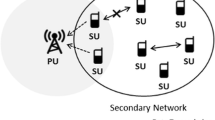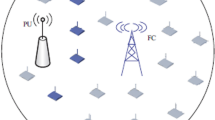Abstract
Existing spectrum sensing methods for cognitive radio do not consider the secondary network’s characteristics to obtain the frequency of spectrum sensing, i.e., the sensing period would be identical for secondary networks that have different traffic characteristics. In this paper, a hybrid sensing algorithm is proposed that finds the optimal sensing period based on both primary and secondary networks’ properties. A continuous-time Markov chain system is used to accurately model the spectrum occupancy, and a novel method is proposed that adaptively varies its parameters to avoid unnecessary sensing tasks, while guaranteeing the priority of the primary network. We conduct simulation work to evaluate the performance of the proposed method. It is shown that the proposed technique outperforms the non-hybrid approach with respect to sensing efficiency and energy consumption. A cognitive sensor network is also considered based on IEEE 802.15.4/ZigBee radios, and it is shown that significant energy savings can be achieved by the proposed method.











Similar content being viewed by others
Notes
The small variation in \(\frac{\sum _{i=1}^{K}T_O(i)}{T_{sim}}\) for the non-hybrid method is due to the fact that the network parameters are stochastically selected through the simulation.
References
FCC. (2002). Spectrum policy task force report, Tech. Rep. 02-135.
Wang, B., & Liu, K. J. R. (2011). Advances in cognitive radio networks: A survey. IEEE Journal of Selected Topics in Signal Processing, 5(1), 5–23.
Mitola, J. (2000). Cognitive radio: An integrated agent architecture for software defined radio. PhD. Diss., Royal Inst. Technol. (KTH), Stockholm, Sweden.
Haykin, S. (2005). Cognitive radio: Brain-empowered wireless communications. IEEE Journal on Selected Areas in Communications, 23(2), 201–220.
Wang, J., Ghosh, M., & Challapali, K. (2011). Emerging cognitive radio applications: A survey. IEEE Communications Magazine, 49(3), 74–81.
Liang, Z., Feng, S., Zhao, D., & Shen, X. S. (2011). Delay performance analysis for supporting real-time traffic in a cognitive radio sensor network. IEEE Transactions on Wireless Communications, 10(1), 325–335.
Zahmati, A. S., Hussain, S., Fernando, X., & Grami, A. (2009). Cognitive wireless sensor networks: Emerging topics and recent challenges. In Proceedings of the IEEE TIC-STH (pp. 593–596).
Chen, Y., Woo, W. L., & Wang, C. (2011). Channel modeling of information transmission over cognitive interrogator-sensor networks. IEEE Transactions on Vehicular Technology, 60(1), 2–15.
Zahmati, A. S., Fernando, X., & Kojori, H. (2011). Emerging wireless applications in aerospace: Benefits, challenges, and existing methods. In Proceedings of the 4th annual caneus, fly by wireless workshop (FBW) (pp. 1–4).
Maleki, S., Pandharipande, A., & Leus, G. (2011). Energy-efficient distributed spectrum sensing for cognitive sensor networks. IEEE Sensors Journal, 11(3), 565–573.
Akyildiz, I. F., Lee, W.-Y., Vuran, M. C., & Mohanty, S. (2006). Next generation/dynamic spectrum access/cognitive radio wireless networks: A survey. Elsevier Computer Networks, 50, 2127–2159.
Xing, Y., Mathur, C. N., Haleem, M. A., Chandramouli, R., & Subbalakshmi, K. P. (2007). Dynamic spectrum access with QoS and interference temperature constraints. IEEE Transactions on Mobile Computing, 6(4), 423–433.
Zahmati, A. S., Fernando, X., & Grami, A. (2012). A continuous-time Markov chain model and analysis for cognitive radio networks. International Journal on Communication Networks and Distributed Systems, 8(3/4), 195–212.
Zahmati, A. S., Fernando, X., & Grami, A. (2010). Steady-state Markov chain analysis for heterogeneous cognitive radio networks. In Proceedings of the IEEE Sarnoff symposium (pp. 1–5).
Yucek, T., & Arslan, H. (2009). A survey of spectrum sensing algorithms for cognitive radio applications. IEEE Communications Surveys & Tutorials, 11(1), 116–130.
Wang, B., Ji, Z., Liu, K. J. R., & Clancy, T. C. (2009). Primary-prioritized Markov approach for dynamic spectrum allocation dynamic spectrum allocation. IEEE Transactions on Wireless Communications, 8(4), 1854–1865.
Liang, Y., Zeng, Y., Peh, E. C. Y., & Hoang, A. T. (2008). Sensing-throughput tradeoff for cognitive radio networks. IEEE Transactions on Wireless Communications, 7(4), 1326–1337.
Ganesan, G., & Li, Y. (2005). Agility improvement through cooperative diversity in cognitive radio. In Proceedings of the IEEE global telecommunications conference (Globecom) (vol. 5, pp. 2505–2509).
Paweczak, P., Janssen, G. J., & Prasad, R. V. (2006). WLC10-4: Performance measures of dynamic spectrum access networks. In Proceedings of the IEEE global telecommunications conference (Globecom) (pp. 1–6).
Atapattu, S., Tellambura, C., & Jiang, H. (2011). Energy detection based cooperative spectrum sensing in cognitive radio networks. IEEE Transactions on Wireless Communications, 10(4), 1232–1241.
Won-Yeol, L., & Akyildiz, I. F. (2008). Optimal spectrum sensing framework for cognitive radio networks. IEEE Transactions on Wireless Communications, 7(10), 3845–3857.
Digham, F. F., Alouini, M. S., & Simon, M. K. (2003). On the energy detection of unknown signals over fading channels. In Proceedings of the IEEE ICC 2003 (pp. 3575–3579).
Tang, H. (2005). Some physical layer issues of wide-band cognitive radio system. In Proceedings of the IEEE DySPAN 2005 (pp. 151–159).
Shankar, S. (2005). Spectrum agile radios: utilization and sensing architecture. In Proceedings of the IEEE DySPAN (pp. 160–169).
Kim, H., & Shin, K. G. (2008). Efficient discovery of spectrum opportunities with MAC-Layer sensing in cognitive radio networks. IEEE Transactions on Mobile Computing, 7(5), 533–545.
Shin, K. G., Kim, H., Min, A. W., & Kumar, A. (2010). Cognitive radios for dynamic spectrum access: from concept to reality. IEEE Wireless Communications, 17(6), 64–74.
Cheng, Y.-C., & Hwang, C. (2006). Use of the Lambert W function for time-domain analysis of feedback fractional delay systems. IEE Proceedings of Control Theory & Applications, 153(2), 167–174.
Part 15.4: Wireless medium access control (MAC) and physical layer (PHY) specifications for low-rate wireless personal area networks (WPANs), IEEE 802.15.4 Standard (2006).
Heinzelman, W., Chandrakasan, A. P., & Balakrishnan, H. (2002). An application- specific protocol architecture for wireless microsensor. IEEE Transactions on Wireless Communications, 1, 660–670.
Maleki, S., Pandharipande, A., & Leus, G. (2009). Energy efficient distributed spectrum sensing with convex optimization. In Proceedings of the 3rd international workshop computing advances in multi-sensor adaptive processing (pp. 396–399).
Author information
Authors and Affiliations
Corresponding author
Appendix: Derivation of \(T_I\)
Appendix: Derivation of \(T_I\)
The Lambert W-function is used to derive \(T_I\) from Eq. (15). Firstly, Eq. (15) is written as \(\zeta = \frac{1-e^ {-\beta T_I}}{\beta T_I}\), where \(\zeta \) is the minimum acceptable \(AOR\). Assume \(x=\beta T_I\), then
Using the substitution \((t = x - \frac{1}{\zeta })\) yields to
Secondly, we use the following property of Lambert W-function [27]
Therefore, \(t = \mathbf W \left( \frac{-1}{\zeta e^{\frac{1}{\zeta }}}\right) \), or \(T_I\) is given by
Rights and permissions
About this article
Cite this article
Sepasi Zahmati, A., Fernando, X. & Grami, A. A Hybrid Spectrum Sensing Method for Cognitive Sensor Networks. Wireless Pers Commun 74, 953–968 (2014). https://doi.org/10.1007/s11277-013-1332-4
Published:
Issue Date:
DOI: https://doi.org/10.1007/s11277-013-1332-4




